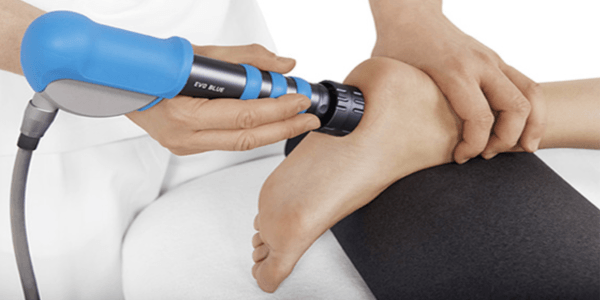Shockwave Therapy
The therapy involves the delivery of high-frequency shock waves to the injured tendon to stimulate healing.
Shockwave Therapy has been used for many years as an alternative to invasive surgeries or traditional rehabilitation.
What is Extracorporeal Shockwave Therapy?
Shockwave Therapy is externally (extracorporeally) administered using a portable device and is also known as:
- Shockwave or extracorporeal pulse activation therapy (EPAT) to stimulate blood supply and metabolism, and promote healing
- Extracorporeal shockwave therapy (EST) may be performed where high-energy soundwaves are delivered to treat nerve problems
- Extracorporeal Shockwave Therapy (EWST)
What Conditions Can Be Treated Using Shockwave Therapy?
Shockwave Therapy is one of many methods used to treat chronic tendon conditions. Injuries that benefit from Shockwave Therapy include:
- Achilles Tendonitis or Achilles tendinopathy
- Shoulder Tendinitis
- Trochanteric bursitis and Hip Pain
- Tennis elbow
- Heel spurs
- Degenerative disorders
- Hip pain
- Proximal hamstring tendinopathy
- Plantar fasciitis (foot)
- Calcific Tendonitis
Shockwave Therapy is a useful treatment for chronic tendon conditions that have not responded to other treatments, it has the advantage of being as effective as some surgery, with no complication of an infection.
Most of the patients who undergo shock wave therapy show significant reduction of pain and improvement in movements of the affected part comparable to other conservative options.
85% of patients in a study treating hamstring tendinopathy demonstrated at least 50% reduction in pain at three months.
Who is Shockwave Therapy Suitable for?
Shockwave Therapy is suitable for injuries that fail to respond to conservative treatment methods such as:
Rest or Pain Medications
Physical Therapy
Where other therapies do not show improvement even when used over a period of 6 months, and is used as an alternative treatment modality to surgery.
Shockwave Therapy
Shockwave Therapy can be used
- Soon after the occurrence of injury to stimulate immediate and ongoing repair, and
- For the treatment of older injuries where calcification or damage of tissue is evident.
- Additionally, Shockwave Therapy is an important adjunct therapy for treating painful tendons or joints suffered by active people.
How Does Shockwave Therapy Work?
Extracorporeal shock waves work on several levels. Pain is initially reduced by hyperstimulation anaesthesia that diminishes nerve pain signals relayed to the brain. The therapy helps by depleting the number of pain mediators emanating from nerve endings, resulting in a reduction of pain experienced.
It also assists in fighting local inflammation and stimulates repair and regeneration of musculoskeletal tissues by improving blood supply to the affected area.
The shockwave energy, although targeted in one area, expands wave-like within the body to heal surrounding areas. The microtrauma associated with shockwave therapy promotes various processes that agitate and heal.
What Does Shockwave Therapy Involve?
Shockwave Therapy is usually administered within the practice, with the patient relaxing comfortably during the procedure.
The Shockwave device delivers acoustic shock waves that penetrate the skin and stimulate natural tissue repair mechanisms. A session involves the following steps:
- The target area is located, marked and applied with ultrasound gel
- Sometimes local anaesthesia.is applied
- A hand-held probe is moved over the skin of the affected site
- The device is held lightly on the skin
- Sound waves are given as short pulses of less than 1 microsecond, with 1 to 4 pulses being applied per second and can involve 1000 to 4000 pulses
- Therefore the treatment can take between 5 to 30 minutes
The number and intensity of the sound waves will depend on the severity of the conditions.
Complete treatment may require 2-5 sessions of therapy at weekly intervals.
Other Applications for Shockwave Therapy
In cases of tendinitis and related disorders, the onset of the condition can be sudden and may appear without the occurrence of associated trauma.
In other instances where damage to an Achilles tendon is experienced as a slight discomfort while actively participating in sport may result in intense pain and inability to walk properly once the tendon has cooled down.
These conditions can last for months or even years if left untreated.
Shockwave Therapy Treatment Process
Preparation for Treatment
The patient should be counselled to ensure that the treatment is understood.
The doctor will:
- Take your medical history,
- Conduct a physical examination, and
- You may be asked to have a number of tests to ensure that Shockwave Therapy is suitable.
- Advise the doctor if you are taking Aspirin or Blood-thinning medications, regardless of whether you are expecting to have treatment or just a consultation.
- Stop any anti-inflammatory medications.
Day of Treatment
- Do not consume large amounts of alcohol for at least 24 hours prior to treatment,
- Avoid vigorous physical activity or exercise for 24 hours,
- Wear loose clothing
Treatment Approach
In some cases, the doctor may recommend either general anesthesia or a local numbing medication be applied to the treatment site. This can temporarily relieve pain.
This can be discussed.
Many patients also experience immediate relief of major symptoms after Shockwave Therapy
During Your Treatment
This procedure can be carried out in minutes at the doctor’s office.
The patient is:
- either made to sit or lie down, while the doctor then administers the Shockwave Therapy treatment.
- may feel a burning or pinching sensation that goes away quickly.
After Your Treatment
Patients are advised that they are:
- Able to walk, drive and return home afterwards without issue
- Should rest the injected area for a day before resuming normal activities.
- Avoid any strenuous activities such as heavy lifting or exercises for a week.
If local pain at the treatment site your doctor
- may prescribe pain relief medication.
- Recommend using a cold compresses to alleviate symptoms.
- Due to the nature of the treatment, the natural healing of the body will continue for several months.


